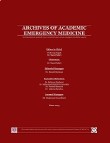A Randomized Clinical Trial of Intravenous and Intramuscular Ketamine for Pediatric Procedural Sedation and Analgesia
Author(s):
Abstract:
Introduction
Ketamine is an agent used broadly for pediatric procedural sedation and analgesia in emergency departments. It has been found to be safe and with a low risk of complications. As choosing between intravenous (IV) and intramuscular (IM) injections is a matter of concern, we did comparison between two methods in terms of their efficacy and the rate of complications. Methods
This single-blind clinical trial study recruited 240 children (age: three months to 15 years, weight > 5 kg), who underwent short and painful procedures at the emergency departments. They were randomly allocated in to two groups of 120 patients to receive either IV or IM ketamine with doses of 1.5 and 4 mg/kg, respectively. Indications for use, dose, side effects, and efficacy of the medications as well as duration of the procedure and time to recovery were compared between two groups. Results
The mean age of the IV and IM groups were 6.5 ± 3.6 and 3.05 ± 2.6 years, respectively (p < 0.001). The onset of action of ketamine was 1.7 ± 1.1 minutes in the IV group and 8.6 ± 3.1 in the IM ones (p < 0.001). Patients of the IV and IM groups remained in optimal sedation for 20.6±12.0 and 37.2±11.8 minutes, respectively (P < 0.001). Time until emergency department discharge was 65.3 ± 36.9 minutes in the IV group and 72.2 ± 14.5 in the IM group (P = 0.40). Ketamine had excellent and moderate efficacy in 66.7% and 32.5% of the IV group and 70.0% and 25.0% in the IM group, respectively (p = 0.02). Totally, 60.0% of IV group patients and 40.0% of IM group experienced drug side effects (p = 0.21). Need to rescue dose was significantly higher in IV group (26.7% vs. 10.0%; p < 0.001). Finally, recovery was tranquil and comfortable in 88 patients (73.3%) of the IV group and 108 patients (90.0%) of the IM group (p = 0.06). Conclusion
We found that although the sedative and analgesic effects of IM and IV ketamine are not significantly different, duration of effect and onset of action are more desirable in the IV group for suturing, fracture reduction, and foreign body removal. Meanwhile, the IM method can lead to lesser need of rescue doses.Keywords:
Ketamine , Analgesia , Sedation , Injections , Intramuscular , Infusions , Intravenous
Language:
English
Published:
Archives of Academic Emergency Medicine, Volume:3 Issue: 2, 2015
Pages:
59 to 63
https://magiran.com/p1400015
دانلود و مطالعه متن این مقاله با یکی از روشهای زیر امکان پذیر است:
اشتراک شخصی
با عضویت و پرداخت آنلاین حق اشتراک یکساله به مبلغ 1,390,000ريال میتوانید 70 عنوان مطلب دانلود کنید!
اشتراک سازمانی
به کتابخانه دانشگاه یا محل کار خود پیشنهاد کنید تا اشتراک سازمانی این پایگاه را برای دسترسی نامحدود همه کاربران به متن مطالب تهیه نمایند!
توجه!
- حق عضویت دریافتی صرف حمایت از نشریات عضو و نگهداری، تکمیل و توسعه مگیران میشود.
- پرداخت حق اشتراک و دانلود مقالات اجازه بازنشر آن در سایر رسانههای چاپی و دیجیتال را به کاربر نمیدهد.
In order to view content subscription is required
Personal subscription
Subscribe magiran.com for 70 € euros via PayPal and download 70 articles during a year.
Organization subscription
Please contact us to subscribe your university or library for unlimited access!


